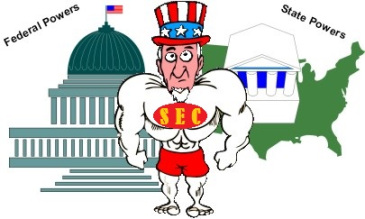
As many of you know, since the release of the final Title IV (i.e. “Regulation A+”) rules earlier this year, Massachusetts and Montana have been have been vehemently contesting the provisions allowing for pre-emption of State regulation with respect to “Tier II” offerings. They have even gown so far as to file a lawsuit against the Securities and Exchange Commission (SEC) seeking to have the final rules overturned. The real problem however, is the States’ short-sighted approach and apparent complete lack of an end game.
The Battle:
Without going into too much detail (believe me, you don’t want to wade through the specific claims unless you are having trouble sleeping), I think a brief review is in order to keep things in context. The recently released final Regulation A+ rules in late March created two tiers of offerings: “Tier 1” offerings of up to $20 million and “Tier 2” offerings of up to $50 million. Under the final rules, Tier 1 offerings would be subject to individual State regulation while Tier 2 offerings made to “qualified purchasers” would not be (I.e. State Blue Sky regulation of Title II offerings would be pre-empted). The key here is to understand that the final rules define a “qualified purchaser” as “any person to whom securities are offered or sold pursuant to a Tier 2 offering” thus pre-empting State regulation of ANY Tier 2 offering.
At the heart of the State’s dispute is the fact that State regulation and oversight of ANY Tier 2 offering would pre-empted under the final rules. Particularly, the States are claiming that the SEC overstepped the authority granted by, and the intent of, Congress in defining the term “qualified purchaser” so broadly as to make the distinction useless (and hence over extend the perceived Congressionally intended limited pre-emption of State regulation). Put another way, the State’s claim is that: (a) the definition of a “qualified purchaser” should be narrowly defined to include only such investors who are capable of
protecting themselves; and (b) only offerings made to such “qualified purchasers” should pre-empt State regulation, not ALL Tier 2 offerings. It should be noted that I have not seen
 the State (or any of its proponents) attempt to define the class of investors who are supposedly capable of protecting themselves and/or offer a better definition of “qualified purchaser.” SEE “Author’s Note Below: I was subsequently informed that NASAA did put forth a proposed definition back in 2002.
the State (or any of its proponents) attempt to define the class of investors who are supposedly capable of protecting themselves and/or offer a better definition of “qualified purchaser.” SEE “Author’s Note Below: I was subsequently informed that NASAA did put forth a proposed definition back in 2002.
In response to the States’ claims, the SEC argues that the final rules can only be overturned if they are “arbitrary, capricious, an abuse of discretion, or otherwise not in accordance with law.” This would require a court to determine both that Congress unambiguously intended to define the term “qualified purchaser” (and/or limit State regulation pre-emption) in a particular way and that the SEC overstepped its delegated authority in setting the final rules (using the two part analysis under the standards of Chevron U.S.A. Inc. v. Natural Resources Defense Council, Inc. (U.S. 1984)). The SEC argues that the States are reading too much into Congress’ use of the phrase “the public interest and the protection of investors” and imposing the need for previously unaddressed criteria based on an individual investor’s wealth, income, and/or respective sophistication (e.g. investors the States claim can “protect themselves”). Moreover, the SEC further argues that its final definition of the term “qualified purchaser” (and the resulting State regulation pre-emption) is entirely consistent with Congress’s goal of opening access to capital markets, not tightening them as would be the result under the States argued criteria, and thus well within the SEC’s delegated authority.
The State of Massachusetts was the first to initiate the contest of the SEC’s rules followed quickly after by the State of Montana. Since then, the North American Securities Administrators Association (NASAA) has signed on as “amici curiae” (which means “friend of the court” … don’t feel bad, I had to look it up also) in support of the States and the National Small Business Association (NSBA) has signed on as amici curiae of the SEC. In addition, various current and former members of Congress and others have issued various supporting briefs on both sides.
For those interested in reading through the actual claims and the pages of pages of paragraph long quotations, outdated Latin phrases, “Id.s,” and expressions of congressional intent, here is a list of some of the more notable related documents that I have seen to date:
- William F. Galvin, Secretary Of The Commonwealth Of Massachusetts v. the Securities and Exchange Commission (SEC) – Petition for Review (May 22, 2015);
- Monica J. Lindeen, Montana State Auditor, Ex Officio Montana Commissioner Of Securities And Insurance v. the SEC – Petition for Review (May 22, 2015);
- Order of Consolidation of USCA Case 15-1149 (Montana) with USCA Case 15-1150 Massachusetts (May 27, 2015);
- Galvin & Lindeen v. the SEC – Petitioners’ Joint Preliminary Statement of Issues (June 22, 2015);
- Galvin & Lindeen v. the SEC – Opening Brief of Petitioners (August 26, 2015);
- Amici Curiae Brief In Support of Petitioners – Filed on behalf of NASAA (September 2, 2015);
- Amici Curiae Brief In Support of Petitioners – Filed on behalf of certain current and former members of Congress (September 2, 2015);
- Galvin & Lindeen v. the SEC – Respondent Brief (September 25, 2015);
- Amici Curiae Brief In Support of Respondent – Filed on behalf of William Michael Cunningham (October 5, 2015);
- Amici Curiae Brief In Support of Respondent – Filed on behalf of William Michael Cunningham (October 16, 2015); and
- Amici Curiae Brief In Support of Respondent – Filed on behalf of the NSBA (October 13, 2015) – NOTE: Originally incorrectly filed in support of Petitioner; Corrected October 14, 2015;
What’s The End Game For The States?
I’ll be the first to admit that I have not analyzed every word of the above documents. Honestly, I do have better things to do despite what you might here, I have however, certainly gone through enough of them to know that the States do not seem to have an end game whatsoever. The documents are filled with page after page of Congress said and intended this, and the SEC did or should have done this, but the States’ position appears to be extremely short-sighted. All the States seem to be cared with is proving that the SEC overstepped its authority, not with proving that what the SEC proposed doesn’t (or won’t) work, and certainly not with offering an alternative solution. Moreover, the States’ arguments seem to be based on an essentially flawed underlying assumption; that the individual States are somehow in a better position to determine what investments are appropriate for their respective residents.
What is the point of trying to defeat something that seems to be working when you do not have a better solution? Even if everything the States lay out in the pages on top of pages of briefs is correct, and even if they are successful in getting the final rules thrown out, then what? Galvin, Lindeen, NASAA, can any of you answer that? Have you bothered to think  that far? I know I quoted this before, but I am again reminded of Jeff Goldblum’s famous line from Jurassic Park, “they were so preoccupied with whether or not they could that they didn’t stop to think if they should.” The States are so concerned with whether or not they can have the current rules overturned that they haven’t stopped to think if they should.
that far? I know I quoted this before, but I am again reminded of Jeff Goldblum’s famous line from Jurassic Park, “they were so preoccupied with whether or not they could that they didn’t stop to think if they should.” The States are so concerned with whether or not they can have the current rules overturned that they haven’t stopped to think if they should.
The old Regulation A was rarely used because the individual State regulations were simply too burdensome, difficult and expensive to deal with to make the transaction worthwhile. The provisions of Title IV were specifically intended to fix the problems with the old Regulation A and make it actually useable; in turn opening up capital to more small business. A win by the States would only mean that all of the progress to date in improving Regulation A will be negated and small business will be forced, again, to deal with the extremely inconsistent and cumbersome individual State rules. History has proven that the old Regulation A was not used for just this reason so what makes the States think that fact will somehow change if they are victorious? Sure there is a higher cap but I highly doubt the increase cap is going to materially change the use of Regulation A if the issuer is forced to comply with the inconsistent patchwork of individual State law. Even given NASAA’s new “coordinated review” procedures which allow issuers to comply with bulks of States at a time, what issuer is going to want to go through the hassle of using Regulation A when there is the potential that one or more of these blocks (or worse yet, the individual States that aren’t even part of any coordinated review block) chooses to reject the offering for whatever reason? If that happens, what should have been a public offering would be turned into a Frankenstein like hybrid where issuers would be freely able to offer securities in certain States but not in others; virtually insuring that the issuer will find himself in trouble with some glory hound of a State’s Attorney for improperly making an offering to the wrong person/people. The SEC’s final rules may not be the best solution to correcting the problems under the old Regulation A but they are at least a solution, which is more than what is being offered by the States.
Another recurring theme I noticed in the above “Petitioner” documents is the idea that the individual States are somehow in a better position to determine what investments are appropriate for their residents. This is further evidenced by the fact that NASAA’s “coordinated review” process is broken up into specific regions (leading to the inclination  that the appropriateness of an investment would be based on geographic region). This idea frankly makes no sense to me. What the hell does geography have to do with the appropriateness of an investment? I can only read this to mean that the “Petitioner” States (and their supporters) somehow believe that the people in one State or region are somehow more intelligent or financially sophisticated than those in another State or region. What about if someone moves? Are they somehow smarter or dumber by moving to a different State? So by the States’ reasoning in their briefs, individual States need the ability to review each deal in order to make sure that the offering is not too complex or risky for their helpless residents? Not sure about the rest of you, but it sounds WAY to “big brother” to me to have someone in my State’s government determining what I can and can’t invest in (especially with the way Illinois’ run’s its budgets.) Besides, I think we all know just how well it can go when a State is tasked with determining whether or not a particular investment is too risky (**cough* Massachusetts ** Apple stock to risky ** cough**). SEE “Author’s Note Below: I was subsequently informed that NASAA’s “coordinated review” process for Reg. A+ offerings is NOT broken up into specific regions as was (and is) the “coordinated review” process for SCOR offerings. That being said, there are still states which apply a “merit” based review standard which would allow the state regulators to ultimately determine what is, and is not, appropriate to allow people to invest in.
that the appropriateness of an investment would be based on geographic region). This idea frankly makes no sense to me. What the hell does geography have to do with the appropriateness of an investment? I can only read this to mean that the “Petitioner” States (and their supporters) somehow believe that the people in one State or region are somehow more intelligent or financially sophisticated than those in another State or region. What about if someone moves? Are they somehow smarter or dumber by moving to a different State? So by the States’ reasoning in their briefs, individual States need the ability to review each deal in order to make sure that the offering is not too complex or risky for their helpless residents? Not sure about the rest of you, but it sounds WAY to “big brother” to me to have someone in my State’s government determining what I can and can’t invest in (especially with the way Illinois’ run’s its budgets.) Besides, I think we all know just how well it can go when a State is tasked with determining whether or not a particular investment is too risky (**cough* Massachusetts ** Apple stock to risky ** cough**). SEE “Author’s Note Below: I was subsequently informed that NASAA’s “coordinated review” process for Reg. A+ offerings is NOT broken up into specific regions as was (and is) the “coordinated review” process for SCOR offerings. That being said, there are still states which apply a “merit” based review standard which would allow the state regulators to ultimately determine what is, and is not, appropriate to allow people to invest in.
My Two Cents.
The best solution here would be for the States to work with the SEC to make the new rules better, not try to tear them apart. For example, here’s MY two part plan on how the States and the SEC could better cooperate in vetting Tier II offerings. First, for those issuers wishing to conduct a Tier II offering, the issuer could be required to go through a through vetting process with their respective State of origination ONLY (this could even be done during the “test the waters” period under Tier II). This can include background checks, fees, etc. Sure it might lead to “formation state” shopping but that should only help keep the States honest in terms of making the process workable. Put another way, to the extent the process is too expensive or cumbersome for the issuer, the issuer could potentially relocate (moving their respective tax revenue with them). Once this State level review is completed and the issuer has been approved by the State, the issuer would then be free to go through the current SEC Tier II process and the offering would pre-empt all OTHER State regulations. Under this method, each State could take individual responsibility for vetting their own domestic entities (which they actually SHOULD be in the best position to do) and the complexity/expense to the issuer of complying with the rules would not be materially increased because they would only have to comply with one State’s particular regulations.
Did the SEC overstep its authority? I honestly don’t know. became a transactional attorney and not a litigator specifically to avoid having to read documents like those above. That being said I can tell you that it really doesn’t matter whether or not they did. The intent of  Title IV was to help open capital markets to smaller business and, from what I can tell, it is doing just that. Are the rules perfect? No, but they are at least effective and in use. If the States want to work to improve the rules, then by all means work WITH the SEC to do so. I am all in favor of that. This lawsuit however, is doing WAY more harm than good. Not only is it causing a black-eye to the legitimacy of the crowdfunding industry as a whole to have State and Federal governments fighting over proper regulation, but the only result that can come of the States prevailing in this lawsuit is to hurt small businesses by setting back the effectiveness of the current rules.
Title IV was to help open capital markets to smaller business and, from what I can tell, it is doing just that. Are the rules perfect? No, but they are at least effective and in use. If the States want to work to improve the rules, then by all means work WITH the SEC to do so. I am all in favor of that. This lawsuit however, is doing WAY more harm than good. Not only is it causing a black-eye to the legitimacy of the crowdfunding industry as a whole to have State and Federal governments fighting over proper regulation, but the only result that can come of the States prevailing in this lawsuit is to hurt small businesses by setting back the effectiveness of the current rules.
I said it before and I will say it again, there is no such thing as a perfect law no matter how carefully anyone attempts to craft one. Best practices are not, and cannot be, written and must evolve from use, trial, error and the glory of hindsight. The States need to recognize this and work to evolve, not fight to strike down, the current rules.
AUTHOR’S NOTE:
After publishing this article I was alerted to certain inaccuracies that I feel deserve noting. First, I had made the statement that neither the States, nor any of their proponents, have attempted to put forth a definition of “qualified purchaser.” I was mistaken as NASAA actually submitted comments to the SEC back in 2002 which, in part, included a very specific proposed definition of “qualified purchaser.” The proposed definition however is even more stringent than that for an “accredited investor” (i.e. meaning even less people would be eligible to participate in a Tier II offering than under a Tier I offering or even a Rule 506(c) offering) so I do not believe it materially affects any of my opinions in the article. Secondly, I was under the false impression that the “coordinated review” process is split up into geographic regions requiring application to, and the approval of, each regional reviewer (i.e. the same as the for SCOR offerings under federal Rule 504). The “coordinated review” process actually only requires a single application to NASAA (through its “EFD”) and the approval of a single appointed “lead disclosure examiner” (as well as a single appointed “merit disclosure examiner” if the issuer intends to offer securities in “merit” based states). While this fact obviously makes my arguments concerning the “geography” of an investor moot, I still do not feel that the individual States, whether as the result of a review by one arbitrarily appointed “lead” State or by multiple State, are in any better position than the SEC to determine the appropriateness of an offering.
As stated in the article, I believe there is something to be gained from having the State do some type of preliminary vetting (e.g. having an Issuer’s state of formation making sure there are no active suits, bad liens, criminal offenses etc. against the Issuer). I still do not however believe that full review of Tier II offerings is warranted or necessary. That’s just simply “my two cents” as noted and should be read as such. I would however like to thank Faith Anderson, Chief of Registration & Regulatory Affairs of the Washington Department of Financial Institutions, Securities Division, for taking the time to alert me of the inaccuracies. The effort is greatly appreciated.

Really interesting perspective (beginning at the bottom) for how states could better work with the federal government on crowdfunding regulation.
Thank you Nichols, much appreciated!